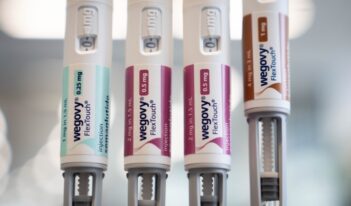
Scholars examine the effectiveness of the contentious 340B Drug Pricing Program.
Prescription drugs are significantly more expensive in the United States than other countries.
To reduce the costs of medicines for uninsured, low-income, or other vulnerable patients, Congress established what has come to be known as the “340B program.” The program gets its name from the legislation that created it—Section 340B of the Public Health Service Act, enacted in 1992. That section requires drug manufacturers that participate in Medicaid to sell drugs to certain “covered entities”—such as rural treatment centers, children’s hospitals, and hospitals that serve a disproportionately high number of low-income patients—at an estimated 25 to 50 percent discount.
One of the most contentious aspects of the 340B program centers on how a health care provider, once certified as a “covered entity,” can purchase drugs at 340B prices for all of its patients, regardless of a patient’s insurance status. The provider can then bill third parties, such as private insurers or Medicare, for the full cost of treatment, and the difference between these reimbursement amounts and 340B discounted prices generates substantial revenue for the provider.
Some critics of the 340B program, including the pharmaceutical industry, have argued that hospitals abuse the 340B program to maximize profits and that they fail to pass along the discounts to their low-income patients. One study found that 340B clinics are increasingly serving more affluent communities, with an emphasis on practice areas with high prescription costs, such as oncology. Defenders of the program, however, contend that the 340B program is an essential source of support for health care providers serving vulnerable populations.
In response to some of these concerns, the Centers for Medicare and Medicaid issued a rule in 2017 that lowered Medicare Part B reimbursement for 340B drugs paid to hospitals. The regulation cut reimbursement by nearly 30 percent, amounting to approximately $1.6 billion a year. The American Hospital Association quickly filed a lawsuit arguing the reduction was “arbitrary and capricious” and in excess of the agency’s statutory authority. That lawsuit has now worked its way to the Supreme Court, with a decision expected sometime next year.
In this week’s Saturday Seminar, scholars explore the 340B program and consider ways that modifying it might better ensure affordable access to pharmaceuticals for low-income individuals.
- A regulatory vacuum surrounding the 340B program has allowed it to stray from its original mission of helping low-income patients, attorney Nicholas C. Fisher argues in an article for the Journal of Health Care Law and Policy. Fisher claims that lack of regulatory oversight from HRSA, in part due to court decisions stripping the agency of its rulemaking authority, has permitted both drug manufacturers and health care providers to subvert the purpose of the program. In addition to calling for Congress to grant HRSA explicit rulemaking authority and to demand greater transparency from 340B hospitals, Fisher urges HRSA to increase the frequency of audits to ensure compliance with the program.
- Samuel Thomas and Kevin Schulman of Stanford University School of Medicine discuss the unintended consequences of the 340B program in an article for Health Services Research. Although the 340B program was intended to increase charity-care and community benefit spending, Thomas and Schulman note that studies reveal that 340B-participating hospitals do not provide more care to vulnerable populations than non-participating hospitals. Thomas and Schulman also note that the 340B program creates a moral hazard issue, since participating hospitals are in a position to financially benefit from increased drug prices. They conclude that policy efforts to reform the 340B program are unlikely to be politically popular and may result in a windfall for pharmaceutical manufacturers.
- The results of a study published in The New England Journal of Medicine and conducted by Sunita Desai of NYU Grossman School of Medicine and Michael McWilliams of Harvard Medical School suggest that hospital responses to the 340B program conflict with the goal of expanding medical care for underserved populations. Desai and McWilliams assert that the program is associated with hospital-physician consolidation and with increased administration of parenteral drugs—drugs which are injected directly into the body rather than delivered orally. Furthermore, their study fails to find clear evidence of enhanced medical care or lower mortality rates among low-income patients.
- In an article for Health Services Research, Sayeh S. Nikpay of the University of Minnesota School of Public Health, Melinda B. Buntin of the Vanderbilt University School of Medicine, and Rena M. Conti of the Boston University Questrom School of Business examine the value of the 340B program by evaluating whether and how much participating hospitals contribute to safety-net care. Nikpay and her co-authors find that new 340B participation is associated with increases in hospital charity care. They find that such increases are completely offset, however, by decreases in other forms of community benefit spending.
- In an article for the Journal of Maternal and Child Health, Rebecca A. Malouin of Michigan State University and her coauthors discuss the high degree of dependency that hemophilia treatment centers (HTCs) have on revenue gained by charging third parties full price for drugs obtained at discounted prices. Over 90 percent of HTCs rely on 340B-related revenue to pay their staff salaries, provide non-billable services, and provide education and community support for patients. In turn, medically vulnerable patients with rare bleeding disorders rely on HTCs to receive accessible and comprehensive care. Malouin and her coauthors recommend that future research be conducted on 340B income utilization at smaller centers and on the level of support that 340B funding provides for various services over time.
- The 340B program may be increasing health care spending by changing providers’ practice patterns, explain Jeah (Kyoungrae) Jung of Penn State University, Wendy Yi Xu of The Ohio State University, and Yamini Kalidindi in an article for Health Services Research. Jung and her coauthors show how the 340B program has contributed to shifts in the location of cancer drug administration away from physician offices and toward hospital outpatient departments, where it is more expensive to provide care. They support decreasing Medicare reimbursement rates for 340B drugs and recommend greater transparency in how hospitals use their 340B revenue.
The Saturday Seminar is a weekly feature that aims to put into written form the kind of content that would be conveyed in a live seminar involving regulatory experts. Each week, The Regulatory Review publishes a brief overview of a selected regulatory topic and then distills recent research and scholarly writing on that topic.



